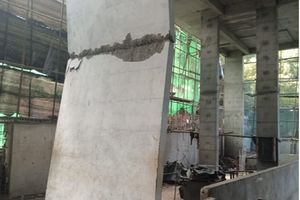Premium
At 60, the future of Sino-Kenya diplomatic ties looks certain

From Left- Principal Secretary State Department for Roads engineer Joseph Mungai Mbugua, Moja Expressway Chief Executive Officer Steve Zhao, Kenya National Highways Authority (Kenha) Director General Eng. Kung'u Ndung'u and Deputy General Manager China Road & Bridge Corporation (K) Liu Chenghui at the Westland's toll station on Tuesday, February 7, 2023.
At 60, Kenya-China diplomacy is on the cusp of a new dawn. Undeniably, anti-China rhetoric during and immediately after the August 9, 2022, General Election shook the foundations of Sino- Kenya diplomatic ties in a palpable way.
Scanning the horizon after the elections and beyond Sino-American global geopolitics, the future of China’s relations with Eastern Africa’s economic powerhouse looks bright and certain. The logic of Kenya’s national interests will engender the strengthening of ties with China, a superpower poised to eclipse the US as the largest global economy estimated at $58.499 trillion by 2050.
From the outset, China embraced Kenya as a valued partner. Beijing was the fourth country to open its embassy in Nairobi on December 14, 1963, two days after Kenya’s independence.
In the new millennium, Sino-Kenya diplomatic ties rest on five planks of connectivity.
The first area is extensive policy consultations as the cornerstone of China’s African policy.
Sino-Kenya ties go back to the ancient ‘Silk Road’ where Africa and China first met. Beijing’s diplomats are, literally, walking in the footsteps of the great Chinese navigator, Zheng He, whose oceangoing fleet visited Kenya many times more than 600 years ago.
In the 21st century, Kenya and China meet on a reimagined new ‘Silk Road’ forged on the anvil of globalisation, but defined by the values of equality, mutual cooperation and solidarity in a fair, just equitable and prosperous world.
In 2005, Kenya adopted its “Look East” policy to seek funds, investment, markets and technologies from China. Critically, Kenya is drawing lessons from China’s Reforms and Opening Up, Beijing’s audacious free-market reforms and trade liberalisation from 1979, which has enabled it to lift more than 850 million citizens out of poverty and to become the world’s second-largest economy. In this context, China and Kenya upgraded their relationship to a Comprehensive Strategic Cooperative Partnership in May 2017.
Sino-Kenya diplomacy is soaring on a new twin architecture of development cooperation. This includes the Forum on China-Africa Cooperation (FOCAC), formed in 2000 as the premier official forum for Sino-Africa policy dialogue.
In 2017, Kenya signed China’s Belt and Road Initiative (BRI), humanity’s most ambitious multitrillion-dollar infrastructure project launched in 2013.
Vision 2030
The FOCAC-BRI agenda has harmonised with Kenya’s Vision 2030. This has enabled Kenya to benefit from massive Chinese funding of development priorities in Africa, including $60 billion in 2015 and $60 in billion in 2018.
The second area of connectivity is infrastructure development. China has funded the expansion and upgrading of Kenyan roads, including the Nairobi-Thika Highway and the Nairobi Expressway.
Kenya is part of a China-funded agenda to build a network of Standard Gauge Railway (SGR) linking the East African region.
In this regard, it signed a treaty with Uganda and Rwanda in 2009 and 2013, respectively, to build a proposed Mombasa-Kigali line.
The proposed transnational line includes a 1,293km track from Mombasa to Malaba.
Kenya’s SGR project, a subject of emotive politics, has three phases.
One is the 485km Mombasa-Nairobi line completed in June 2017 at an estimated cost of US$3.8 billion.
Two is the 124km Nairobi-Naivasha track, politicised and parodied as “Railway-to- nowhere”.
Finally is the 520km Naivasha-Malaba track and a 174km branch linking the main SGR line to Kisumu. China also completed a new Kipevu Oil Terminal (KOT) in Mombasa, at $385 billion.
Additionally, China is supporting the Lamu Port-South Sudan-Ethiopia Transport (Lapsset) corridor project.
Under this project which is estimated to cost $2.5 trillion upon completion, Kenya will build a 1,350km SGR line linking the Lamu Port to the South Sudan border point of Nadapal and a 700km Nairobi-Moyale line connecting Kenya to Ethiopia.
Kenya’s new railway and port network is expected to create at least 100,000 direct employment and another 400,000 indirect jobs, attract more investors, enhance industrialisation, expand Kenya’s tax base, increase local manufacturing, and accelerate Kenya’s integration into the global market.
China is also supporting the building of the Konza Technopolis, Kenya’s largest technology hub, fittingly billed as ‘Africa’s Silicon Valley’.
The third area of connectivity in Sino-Kenya relations is trade promotion. China is Kenya’s leading trade partner. The value of Sino-Kenyan trade reached an all-time high of $192 billion in 2019. Diversification and value-addition of Kenya’s exports can reverse its trade deficit with China.
Removing tariffs
In January last year, China and Kenya signed six bilateral trade agreements that focused on removing tariffs and other trade and non-trade barriers.
Again in August last year, Kenya became the first African country to export fresh avocados to China.
The fourth area of connectivity is financial investments. Some 106 Chinese firms are operating in Kenya, hiring nearly 50,000 Kenyans, 78 per cent are on a full-time basis and 95 per cent are part-time employees.
China is also Africa’s main source of affordable technology.
Beijing is also Kenya’s largest bilateral lender and greatest source of concessional loans. As of 2019, China accounted for 72 per cent of Kenya’s overall foreign debt. This has led to allegations that China is luring Kenya into a debt trap, burdening it with debt it cannot pay.
The fifth area is people-to-people exchanges involving Kenyan and Chinese citizens. One area of people-to-people diplomacy is tourism. China is one of Kenya’s growing source markets for tourists.
On February 11 this year, Kenya received the first group of 205 Chinese tourists after the Covid-19 pandemic. Kenya needs a strategy to attract more Chinese tourists, who will reach 200 million by 2030.
Two, Kenyan universities host four Confucius institutes as platforms of cultural diplomacy.
On April 26, 2023, Kenya launched a one-year Chinese language training programme tailor-made for the Kenya Defence Forces troops. More and more Chinese are learning Kiswahili, enhancing Sino-Kenyan cultural ties.
Three, China is also the fastest-growing destination for Kenyan students. Since 2015, China has provided around 67,000 training opportunities for Kenya, according to the Chinese embassy in Kenya.
In 2019, a total of 2,400 Kenyan students were enrolled in Chinese learning institutions.
Since January 2022, China has extended areas of the Kenya-China partnership to include resolving regional conflicts. Beijing has since appointed a special envoy to the Horn of Africa.
Anti-China rhetoric characterised the 2022 campaign moment. But since assuming office, the Kenya Kwanza government has toned down the rhetoric and reversed its stance on Beijing.
“You can’t upset one of your biggest creditors,” noted Aly-Khan Satchu, Kenya’s political economist.
Sino-Kenya diplomacy has returned to a more pragmatic path. And with this, the future of Kenya-China relations looks certain—and bright.
Prof Kagwanja is the author of Shared Prosperity: Tracking the Belt and Road Initiative in Kenya, 2018-2021 (November 2021).





